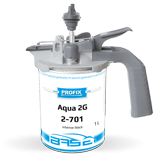Recently added
Most read
Why use the water-soluble lacquers, when the conventional ones are available?
How difficult is it to become a colourist?
How difficult is it to become a colourist?
First, let us try to answer the question of who a colourist actually is? For outsiders, it most probably means an employee of a varnish mixing shop. However, it is not so straightforward. A colourist is not someone who works at a mixing lab and makes colours by relying solely on formulas.
Instead, a colourist is someone with the right skills to tint colours, to create colours without using formulas, who is able to use test sprays to assess colours and, most of all, to assess colours correctly and to define differences between them. We can say that a colourist is a professional experienced in working with colours and able to use the knowledge they have gathered over the years efficiently.
I think that in Poland the profession in question is seen as rather exotic due to its unique character, which is difficult to define for people from outside the sector; which is why it is often underappreciated. While training in various corners of the world, I noticed that for instance in Russia and former Soviet republics, the person responsible for mixing colours holds a very high position in the team/company/workshop and they are well-paid and recognised. Interestingly, on those markets the employees of car paint mixing plants are mainly women, which, in a trade dominated by men, is unique on the global scale. However, when we consider the results of studies on the perception of colours by men and women, it gives us a completely different perspective.
Here I shall refer to study results which indicate that specific cells in the eye are responsible for correctly distinguishing between colours, while the presence of such cells depends on X chromosome. With two X chromosomes, women are equipped with much more specialised cells that facilitate colour perception. Moreover, around 40% of the female population is tetrachromatic, which means that they have 4 different types of cells responsible for seeing colours, while other people only have 3 types. To understand how this translates into colour perception we can analyse how people see the colours of the rainbow. When looking at a rainbow, people with 3 types of colour perception cells see 7 colours: red, orange, yellow, green, blue, indigo and violet. Whereas tetrachromatic people see as many as ten colours.
Now that we know who a colourist is, we can try to answer the question of how difficult it is to become one. Most often, there are two career paths that lead to this position:
- a painter/varnisher, who already works at the paint mixing plant, is delegated to colour mixing;
- or an employee of a shop selling car spray paints may become a colourist.
In theory, the transition is easier for the painter/varnisher and their adaptation process is much shorter, as in their work they already deal with acrylic, base coat and water-based paints. They already know what tinting is, what a well-matched colour should look like and what impact pressure, the number of coats, amount of solvent and the use of the right undercoat have on the final colour.
Ironically, the worse the colour selection system is, the faster the employee becomes a colourist, because they have to additionally tint formulations and in doing so, they gain basic knowledge on the exciting art of tinting.
Over many years of working with colourists, I was able to observe a very interesting phenomenon. Namely, an employee who has already "tasted" what it is like to work as a colourist will stay in this profession for many years, they may just change the employer and/or the brand of paint they use to mix colours. The rotation level in this regard may be quite high sometimes.
It is also worth considering that it is often the colourist who decides what brand of paint the mixing plant uses or what brand of paint the shop sells. It is a result of year-long habits, preferences or learned colour selection procedures. Due to the above, their preferred paint brand often follows the colourist when they change their place of work.<
It is also worth stressing that once a person has mastered the art of matching car paints and can move freely between them, their place of work and the brand of paint they happen to work with, in reality, are not very important.
Of course, an adaptation period is always needed, for some it will be longer and for some it will be shorter, but an experienced colourist can find their place in a new environment very quickly, they do very well with any new systems and new brands of paint.
The reason behind this fast adaptation is simple – the correlations between colours, mutual effects of colourants, knowledge whether an individual component is transparent or concealing, whether it has thick or fine grain, the way a given toner dyes, how to distinguish between xirallic and pearl – is all very universal knowledge, used practically in the same way, irrespective of the paint selection system.
To sum up, one often becomes a colourist by chance, then they spend several years gathering the necessary experience, which is then used while working with other systems.
The car paint market is evolving, the systems are becoming better and so-called "old school" colourists are disappearing, as there is no need to interfere with the formula too much to achieve the desired effect. Currently, efficient and fast tinting of water-thinnable paint is challenging, with the main problem being the difference in shade when we look at it "wet", compared to the shade after painting. For colourists used to working with conventional paint, it may prove to be an obstacle which is very hard to overcome. In case of the Aqua 2G water-based system (from Profix), this issue is virtually eliminated, so there is no need to change the habits formed while working with traditional systems.









